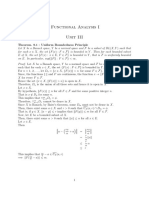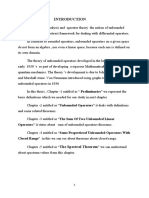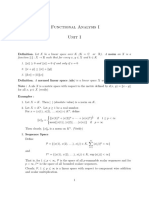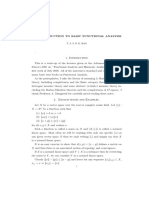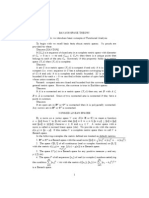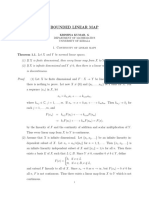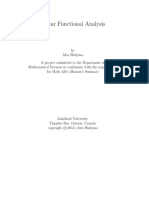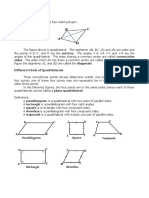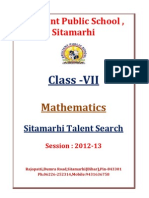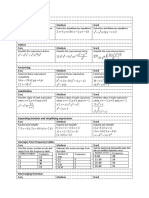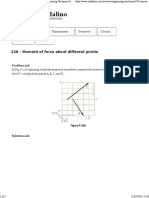1
Functional Analysis
Binod Chandra Tripathy
Department of Mathematics
Tripura University
Agartala- 799022, Tripura
Book to be followed
Functional Analysis by Balmohan V. Limaye
New Age International Ltd.
Compact Operators on Normed Linear Spaces
Definition. Let X and Y be linear spaces over the field
of scalars K. Then the function F:X→Y is said to be
linear if
F(k1x1+k2x2) = k1F(x1) + k2F(x2),
for x1, x2 X and k1, k2K.
Example. Let X = R, the set of real numbers, which is a
real vector space. That is the field of scalars is R.
Consider the function f: RR be defined by
2
f(x) = 2x, for xR.
Then we have,
f(k1x1+k2x2) = 2(k1x1+k2x2)
= 2k1x1+ 2k2x2
= k1(2x1) + k2(2x2)
= k1f(x1) + k2f(x2)
Hence, f is a linear function on R.
Problem. Verify whether the function f: RR defined
by
f(x) = 2x+7, for xR
is linear or not.
Result. A linear map F:X→Y, where X and Y are
normal linear spaces is said to be continuous if and only
if F(U) is bounded in Y, where U is the unit ball in X.
Definition. A subset B of a linear space is said to be
compact, if every open cover has a finite subsocver.
Definition. A linear map F from a normed linear space
X into the normed linear space Y is said to be compact if
the closure of F(U) is compact subset of Y.
3
Note. A Compact linear map is also known as
completely continuous linear map.
Remark. A compact subset of Y in a normed linear
space is bounded, so a compact linear map is
continuous.
Definition. A subset E of a metric space X is said to be
totally bounded if for a given >0, there exists x1, x2, . .
., xn such that.
EU(x1, )U(x2, ). . . U(xn, ),
where U(xk, ) is an open ball at xk of radices , for k =
1, 2, . . . , n.
In view of the above definition, we have the following
results.
Result. Totally boundedness is a hereditary property.
That is if A B and B is totally bounded, then A is
totally bounded.
Result. In a metric space X, a subset and E is compact if
and only if every sequence has a convergent
subsequence if and only if X is complete and totally
bounded.
4
Remark. A compact subset Y of a normed linear space
X is bounded, so a compact linear map is continuous.
The converse is not necessarily true. This follows from
the following example.
Example. Let X be an infinite dimensional linear space.
Consider the identify map I.
Clearly, I is linear and bounded, so is continuous.
Consider the unit ball U and its closure i.e.
U ={xX: ||x||≤1}.
Consider the open cover V of U as follows:
V={B(ek,1), B(-ek,1), k =1, 2, . . . }{},
where is the zero element of X.
Thus the open cover V cannot be reduced to a finite
sub-cover for U. Hence I is not compact.
5
Notation. The following notations will be used
throughout. Let X and Y be two linear spaces, then
L(X,Y) = Linear maps from X to Y.
BL(X,Y) = compact maps from X to Y.
BL(X) = Bounded linear maps from X to X.
C(X,Y) = Compact maps from X to Y.
6
Theorem. Let X and Y be normed linear spaces, and
F:X→Y be linear map. Then F is a compact map if and
only if for every bounded sequence (xn) in X, (F(xn)) has
a subsequence which converges on Y.
Proof. Let F be compact and (xn) be a bounded
sequence in X. Let, >0 be such that
||xn|| <, for every nN.
||xn||-1 <1, for every nN.
||-1xn|| <1, for every nN, since ||.|| is linear and
continuous.
Thus, (-1xn)U.
xn ________
F F (U )
xn ________
We have F a bounded sequence in Y, since F (U )
is bounded, by hypothesis F is compact. Thus by
xn
Weierstrass completeness principle F has a
convergent subsequence.
7
xn j xn
F F .
Let be the convergent subsequence of
This implies, F xn
1
j is convergent.
Which implies, F xn j is convergent.
Thus, we have (F(xn)) has a subsequence which
converges on Y.
Conversely, suppose that for every bounded sequence
(xn) in X, (F(xn)) has a convergent subsequence in Y, to
show that F is compact.
Now construct a sequence (yn) in Y such that
||yn - F(xn)|| < n-1, for all nN, . . . . . . . (1)
where (xn) is a bounded sequence in U.
We have, (F(xn)) has a convergent subsequence in Y.
be the subsequence such that, lim F ( x
Let F xn j j
nj )
exists in Y.
Let, lim F ( xn j ) y .
j
By (1), we have lim yn j y Y.
j
8
________
Hence we have (yn) a sequence in F (U ) , which has a
convergent subsequence.
________
Hence by a known result, F (U ) is compact, which
shows that F is compact.
Theorem. Let X be a metric space. The following
conditions are equivalent.
(i) X is compact.
(ii) Every sequence in X has a convergent subsequence.
(iii) X is complete and totally bounded.
We can generate a metric from the norm on the space.

